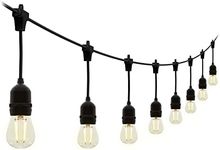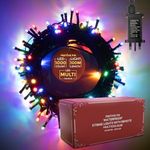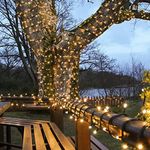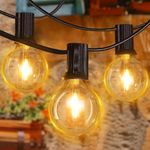Buying Guide for the Best Outdoor String Lights
Outdoor string lights are a fantastic way to add ambiance and charm to your outdoor spaces, whether it's a backyard, patio, or garden. When choosing the right outdoor string lights, it's important to consider several key specifications to ensure they meet your needs and preferences. These specifications will help you determine the durability, brightness, energy efficiency, and overall aesthetic appeal of the lights. By understanding these factors, you can make an informed decision that enhances your outdoor environment.Bulb TypeThe bulb type is crucial as it affects the brightness, energy efficiency, and longevity of the lights. Common types include LED, incandescent, and solar-powered bulbs. LED bulbs are energy-efficient, long-lasting, and available in various colors and brightness levels. Incandescent bulbs offer a warm glow but consume more energy and have a shorter lifespan. Solar-powered bulbs are eco-friendly and cost-effective but depend on sunlight for charging. Choose LED bulbs for energy efficiency and longevity, incandescent for a classic look, or solar-powered if you want an environmentally friendly option.
Length and CoverageThe length of the string lights determines how much area they can cover. It's important to measure the space where you plan to hang the lights to ensure you purchase the right length. String lights come in various lengths, from short strands for small areas to long strands for larger spaces. Consider the layout of your outdoor area and how you want the lights to be arranged. If you have a large area, opt for longer strands or multiple sets to ensure adequate coverage. For smaller spaces, shorter strands may suffice.
Weather ResistanceWeather resistance is a critical factor for outdoor string lights, as they will be exposed to the elements. Look for lights that are labeled as weatherproof or waterproof, which means they can withstand rain, wind, and other outdoor conditions. The IP (Ingress Protection) rating indicates the level of protection against dust and water. A higher IP rating, such as IP65, offers better protection. Choose lights with a suitable IP rating based on your local climate and the level of exposure to the elements.
Power SourceThe power source of outdoor string lights can be electric, battery-operated, or solar-powered. Electric lights require an outlet and are ideal for permanent installations where power access is available. Battery-operated lights offer flexibility and portability, making them suitable for temporary setups or areas without power access. Solar-powered lights are eco-friendly and cost-effective, as they charge during the day and illuminate at night. Consider your power access and installation preferences when choosing the power source.
Brightness and Color TemperatureBrightness and color temperature affect the mood and functionality of your outdoor space. Brightness is measured in lumens, with higher lumens indicating brighter lights. Color temperature is measured in Kelvin (K) and ranges from warm (yellowish) to cool (bluish) tones. Warm lights (around 2700K-3000K) create a cozy, inviting atmosphere, while cool lights (above 4000K) are more energizing and suitable for task lighting. Determine the ambiance you want to create and choose the brightness and color temperature accordingly.
Style and DesignThe style and design of outdoor string lights contribute to the overall aesthetic of your space. Options range from classic globe bulbs to vintage Edison bulbs and modern fairy lights. Consider the theme and decor of your outdoor area when selecting the style. Globe bulbs offer a timeless look, Edison bulbs add a vintage touch, and fairy lights provide a whimsical feel. Choose a design that complements your outdoor setting and enhances the desired atmosphere.












![Festive Fix Christmas Tree Lights – 200 LED, 20m Waterproof String Decorations with Remote & 8 Modes – Energy-Saving Indoor/Outdoor Xmas Lights for Home, Garden & Weddings [Cool White/Warm White]](https://images-proxy.bestreviews.guide/ccXsL___rbEqf_mNz9enI5_8Uks=/0x150/https://m.media-amazon.com/images/I/510sFWIZ7mL._AC_CX679_.jpg)

